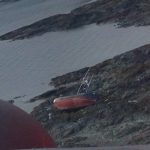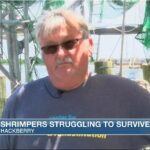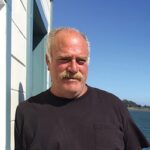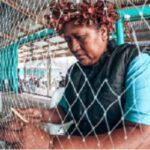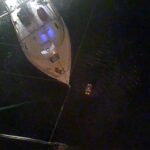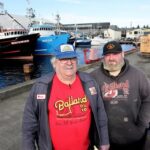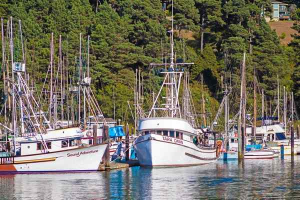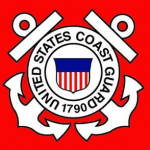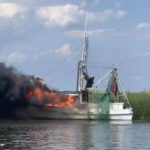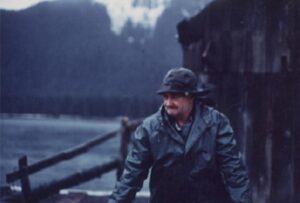Grand Bank protest – ‘SOMEONE IS GOING TO HAVE LISTEN TO THE FISHERMEN’
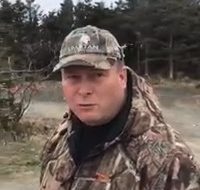 Fisherman Wayne Meade and a handful of other harvesters burned crab pots and gill nets Tuesday morning outside his home in Grand Bank. “We figured we’d make some smoke,” said Wayne, adding it was a sign of support for crab fishermen in Port au Choix who held a protest fishery there Monday.
Fisherman Wayne Meade and a handful of other harvesters burned crab pots and gill nets Tuesday morning outside his home in Grand Bank. “We figured we’d make some smoke,” said Wayne, adding it was a sign of support for crab fishermen in Port au Choix who held a protest fishery there Monday.
•••
Said Wayne:
“All our scallop grounds was took from us. Our 10 per cent halibut bycatch fishery was took from us. So we’re left with nothing, with our hands tied behind our backs. Jesus, we’ve been always treated like dirt. Even in the world wars they put the Newfoundlanders up front to be shot and slaughtered like sheep. So it’s time for us to wake up and be counted. It’s crazy the stuff that’s going on. And like I said, DFO is sitting on a keg of gunpowder, and the FFAW. And she’s going to blow. I don’t know when, but she’s going to blow. Something is going to come out of this. Somebody is going to sit down and listen. Because I mean to say we’ve been tied down too long. Someone is going to have to listen to the fishermen.”
•••
On Tuesday, April 11, FISH-NL made a presentation to the province’s federal Liberal caucus in Ottawa, including recommendations on how to deal with the current fisheries crisis.
The presentation was made by Ryan Cleary, President of FISH-NL, and Richard Gillett, Vice-President. Find the presentation here
The following are FISH-NL’s recommendations for fishing zone 3Ps:
FISH-NL recommends a 10,000-tonne index cod fishery. The first 10,000 tonnes of the quota off the south coast must be the exclusive jurisdiction of the inshore fishery. DFO science has  recommended a cut in the 3Ps cod quota, which was set at 13,000 tonnes in 2016 (although only 7,000 tonnes were caught). In 2015, just 42 per cent of the cod quota was caught. It’s expected that this year’s quota will be set below 7,000 tonnes. When the cod fishery was reopened in 3Ps in 1997 the first 10,000 tonnes were reserved for the inshore. Offshore trawlers were not permitted access.
recommended a cut in the 3Ps cod quota, which was set at 13,000 tonnes in 2016 (although only 7,000 tonnes were caught). In 2015, just 42 per cent of the cod quota was caught. It’s expected that this year’s quota will be set below 7,000 tonnes. When the cod fishery was reopened in 3Ps in 1997 the first 10,000 tonnes were reserved for the inshore. Offshore trawlers were not permitted access.
FISH-NL recommends a 250-tonne halibut quota. 2015 was the first year there wasn’t a directed halibut fishery in 3Ps, as most halibut was caught by larger vessels, the majority from outside the province. FISH-NL also recommends reinstitution a year-round halibut bycatch BACK to 10 per cent.
FISH-NL recommends inshore scallop harvesters be granted access to all three beds on the St. Pierre Bank. Harvesters are currently restricted to fishing on the northern scallop bed. They want permission to once again fish in the other two areas — the Southern and Middle beds. Those beds have been reserved for the offshore fleet from Nova Scotia since 2006, when — upon the recommendation of David Hooley — the federal Department of Fisheries and Oceans implemented fleet separation for sea scallops.
FISH-NL recommends DFO issue more fishing permits for sea cucumbers on the Southern and Middle beds of the St. Pierre Bank. Harvesters would like to see more permits issued, but with conditions. In order to make a permit a permanent licence a harvester must have fished sea cucumbers for two consecutive years, with a minimum number of pounds landed.
Ottawa must compensate Placentia Bay lobster fishermen for catching green crab, an invasive species brought into the area by oil tankers. Green crab has been eating small lobster and seagrass, habitat for the lobsters. Lobster have practically disappeared from Placentia Bay.
The minimum length of herring must be reduced to 9.5 inches from 9.75. The tolerance for undersized is currently 10 per cent, which should be increased to 15 per cent.
FISH-NL supports an enterprise buyout for 3Ps fishing licences, reducing the number of active harvesters. Any such buyout program should be overseen by a government agency — not a union. FISH-NL must be given an opportunity to consult with its 3PS membership and offer advice on the criteria for eligibility, the approval process details, and methodology for determining enterprise value. Harvesters in 3Ps say two-thirds of the under 40-foot fleet should be bought out (over 200 harvesters in Placentia Bay alone), and one-third of the supplementary, over 40-foot fleet.
The fixed gear inshore fleet in Fortune Bay must be allowed to use tuck seines in the herring fishery (the same as they’re permitted in the mackerel fishery), and the same as other fleets around the province.
Contact Ryan Cleary: 6824862

































